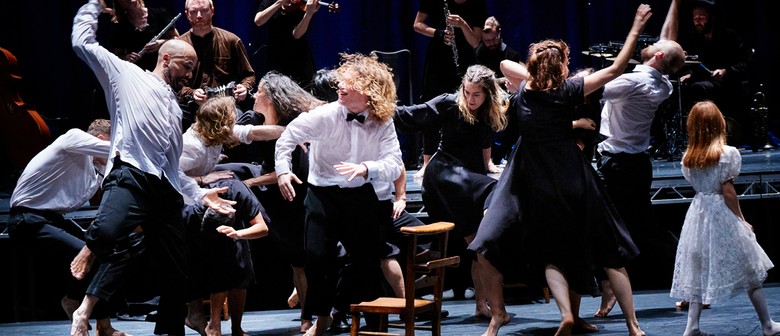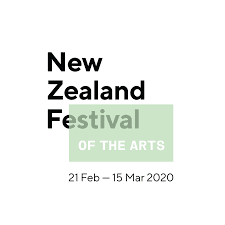Creator Lemi Ponifasio told an afternoon crowd prior to the closing performance of his latest masterwork, Jerusalem, that he was "motivated by (looking) for a new way of feeling or knowing about things." He was also quick to note that the idea of a performance ina theatre was a 'European concept'.
Playing to a crowd, who payed and sat politely, was a "colonising" act, he argued. In other cultures, performance was not seperated or an act for the elite and discerning. It was part of the fabric and make up of ritual, culture, society.
But now 'art', 'music', dance are a boxed off concepts. Why, he asked, do we have to put things in a colonial frame to get noticed or respected?
He also challenged his audience. Much of what you will see, he thought, would only be available if you spent time in porirua, and not in the city. "Why is it that the stories you will be watching (tonight) are about the people who can not, or will not come to a theatre like this (the Opera House) because of culture, education or money."
He asked "How do you find a way of involving people in a way that was really involving - not just paying lip service?" For him, the concept of Jerusalem is a complex utopia, where peple are not settled - but instead constantly busy, in conflict, moving, ideas are changing, fluid.
He challenged the ideas of 'democracy'. Was democracy really in action when two parties stubbornly remain on either side of the fence, unable to meet in the middle or see the other side of the story - as in curent American elections. "Jerusalem emerges," Ponifasio writes in the show's introduction notes, "from a perplexing and tumultuous global context scarred by pervasive violence, systemic displacement, hate-crimes and the spectre of clashing assemblages of power, religion and ideology."
The Palestinian (arabic) name for Jerusalem is Al-Quds. It means ‘the Holiness’, the ‘Holy One'. It is a place where ideas, people and cultures clash. Like people. It is one of the most contested places in human history – "perpetually held hostage in the shadow of competing divine archetypes, which police and divide life on earth."
The performance opens with an entirely bare stage, dark at first, opening out to a room filled with dark blue light and dry ice. The operal house stage looks almost daunting. It's vast. You immediately feel like you are looking at a wasteland in large landscape. The bones are revealed, radiators at the back, bricks, girders, all become part of the industrial landscape. Or perhaps an ancient wall.
A dawn haze, perhaps. There is nothing on stage except for a simple thin boxlike gazebo, a frame of thin poles that make up artifical walls to a house, prison of even a Marae. Behind is the expose back wall of the opera house - 3 stories high, symbolising the 'Wailing Wall', or something else, perhaps. When Jerusalem begins there are layers of chanting - these are the residents in a quarantined city, shouting into the night, “Wuhan jiayou!” – “Wuhan stay strong”. They call out to each other from the windows of their locked rooms in their "barricaded highrises". They shout cries of self-encouragement and form "a latent counterpoint to the fragments of traditional muqam folk music of the Uighurs".
The Ulghus, I learn are a Muslim ethnic minority from the Xinjiang province, many of whom have also been ‘quarantined’ for 're-education', a 'cure' for what China sees as 'the mental ilness of islam.'
This is disturbing on many levels. No more so than when you contrast is with the pakeha policies adoped up until the mid-20th Century to rid the country of Te Reo and Maori culture altogether. I found it profoundly moving that over 90% of the performance was actually in Te Reo, spoken, sun, chanted with execeptional skill and pride. The mother tongue of Aotearoa, once forbidden by the colonisers is the voice of Jerusalem.
It's ironic even more so when you think of the lyrics of William Blake's most famous and very English poem - and hymn:
And did those feet in ancient time,
Walk upon Englands mountains green:
And was the holy Lamb of God, On Englands pleasant pastures seen!
And did the Countenance Divine, Shine forth upon our clouded hills?
And was Jerusalem builded here, Among these dark Satanic Mills?
"Visions of Jerusalem appear again and again across times and places, throughout history, from enslaved Africans in the Americas, to British nationalists and Sufragettes; from the Whanganui river community with James K Baxter, to Ngāi Tūhoe Maungapōhatu with Rua Kēnana. Jerusalem is a site composed of contradictory fragments that form shape-shifting patterns entangling the real and the imagined – a space of despair and promise"
Using Te Reo is an immediate shout in the face of white supremicists. One of which dared to challenge the evil acts of last March - and those that cowardly followed.
Ponifasio has added an iteresting twist - with a warrior challenge, performed on an invisible meeting ground by Opera singer Kawiti Waetford, but instead of a taiha, an armalite semi-automatic is brandished. It's a dark reminder of what has recently been, and a tribute of the aroha the country chose to show to their muslim community, in an act of solidarity. Waetford's voice is strong, almost mesmerising. He chants under his breath at ties, like a spell of unresolved dissonance.
Ponifasio sets out to transform traditional lament and prayer into ceremonial rites that (he says) "open a space to question the order of things, and move together towards reparation, death and regeneration."
He's done this, skillfully, braiding together Syrian poet Adonis' (Ali Ahmad Sa’id Esber) epic poem, Concerto al-Quds, with strands of Maori and Chinese Muslim language and culture.
Adonis is one of this (and last) century's most influential poets. He's as widely read as T.S.Eliot in the English speaking world. He is a perenial contender for the Nobel Prize in literature. Now in his 90's, he still speaks with a loud. resonant voice, having recently supported and challenged aspect of the uprising of the Arab Spring and other events in the region.
In 1956 he was forced to leave Syria after being involved with the Syrian Nationalist Party. He relocated to Paris after many years of unsettled living. He was named a Commander of France's Order of Arts and Letters in 1997. In 2011 he was awared the Goethe prize in Germany.
He drew controversy around Jerusalem itself when he had controversial meetings with Israelis. He was well-known for his secular stance, and use a ‘pagan’ name (i.e. Adonis) led to the expulsion from the Arabic Writers Union, various Salafi death threat Fatwas, and calls for his books to be burned.
The show is littered with imagery and metaphor. Performers move very slowly, with deliberate tiny steps and careful gestures, to emphasise every action, every detail. Women, dressed in back, resemble the wahine of an iwi, tasked with preparing a body for a tangi. One Chinese woman appears in black clothing reminescent of the Mao days.
A Kamatua (played by a very animated Tame Iti) appears several times to chant and challenge. Ironically, he is dressed in the clothes of a rich investment banker, instead of the usual treasured 70's polyester suit, favoured by our seniors. Another nod to colonial oppression, perhaps. Or a reclaiming?
Scenes interweave. The soundtrack is a perpetual hum, perforated by sirens, shouting, the sounds of crowd hysteria, gunfire. Stanza's from Adonis' poem crawl acrross the back wall, appearing line by line in four columns. There is one especially challenging scene towards the end of the show when a Chinese man (Ery Aryani) , perhaps one of the aforementioned Ulghus, is presented with a washbowl of a black liquid. Is it tar? For shame. Is it blood? Mud? Death?
 |
| Ery Aryani (Photo - NZ Festival of the Arts) |
His death, cordoned off by yellow tape, yet another Colonial approach (treated with suspiciaon, not repect). It ends with the lowering of a huge white sheet, which the cast spread out accross the stage - as a road to heaven, or river. It's not clear.
Perhaps this is how we get to Jerusalem?
Jerusalem is a complex performance. It's profound. it certainly lived up to Ponifasio's promise: This performance won't entertain but it will challenge you, make you think, drive you to uncomfortable places, abandon you, leave you spinning around, searching deperating for a signal. It certainly did that.
Review by CoffeeBar Kid
Lemi Ponifasio is one of three curators at this year's Festival of the Arts. He is also founder of MAU, which began in 1995 working with diverse cultures and communities around the world. His collaborators are performing in factories, remote villages, opera houses, schools,marae, castles, galleries and stadiums.
Mau is the Samoan word meaning the declaration of the truth. Lemi Ponifasio is acclaimed internationally for his radical work as a choreographer, stage director and designer, and for his collaborations with many communities.
The projects have included fully staged operas, theatre, dance, exhibitions, community forums and festivals in more than 30 countries. He has presented his creations with MAU in many places including Festival d’Avignon, Lincoln Center New York, BAM New York, Ruhrtriennale, LIFT Festival London, Edinburgh International Festival, Theater der Welt, Festival de Marseille, Theatre de la Ville Paris, Onassis Cultural Centre Athens, Holland Festival, Luminato Festival Toronto, Vienna Festival, Santiago a Mil Chile, the Venice Biennale and in the Pacific region.
His recent works include Love To Death (2020) with MAU Mapuche, Santiago Chile; KANAKA (2019) with Theatre Du Kanaky, New Caledonia; Mausina with MAU Wahine for 125th anniversary of women’s suffrage in New Zealand (2018) and Standing In Time (2017) with MAU Wahine; Die Gabe Der Kinder (2017) with children and community of Hamburg; Ceremony of Memories (2016 and 2017) with MAU Mapuche of Chile; Recompose (2016) with MAU Wahine and Syrian women for Festival Herrenhausen, Hanover; Lagimoana Installation (2015) for the Venice Biennale 56th Visual Arts Exhibition; Apocalypsis, Toronto (2015); I AM: Mapuche, Chile (2015) and I AM for the 100th Anniversary of WW1 (2014), which premiered at Festival d’Avignon.
Other major international performance tours by Lemi Ponifasio and MAU include The Crimson House (2014), Stones In Her Mouth (2013), the opera Prometheus by Carl Orff (2012), Le Savali: Berlin (2011), Birds With Skymirrors (2010), Tempest: Without A Body (2008), Requiem (2006) and Paradise (2005).
- Bio supplied by NZFestival of the Arts

















































